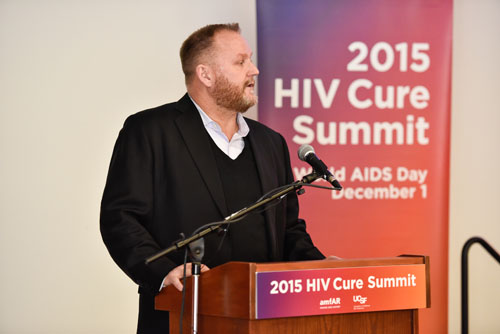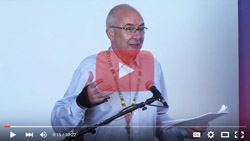Progress, Plans, and the Prospects for a Cure
Researchers deliver community update at 2015 amfAR HIV Cure Summit
amfAR teamed up with UC San Francisco for the second annual HIV Cure Summit on World AIDS Day, December 1, at the UCSF Mission Bay campus.

amfAR CEO Kevin Robert Frost
The summit followed a November 30 press conference where amfAR announced the establishment of the amfAR Institute for HIV Cure Research, supported by a five-year $20 million grant to UCSF. The Institute will support teams of scientists working across the research continuum—from basic science to clinical studies—and will tap into UCSF’s extensive research network across the region. It will involve collaborations with the Gladstone Institute of Virology and Immunology (GIVI) and Blood Systems Research Institute, as well as Oregon Health and Science University;  Paul Volberding, M.D.University of California, Berkeley; Gilead Sciences; and the Infectious Disease Research Institute in Seattle, Washington.
Paul Volberding, M.D.University of California, Berkeley; Gilead Sciences; and the Infectious Disease Research Institute in Seattle, Washington.
Following introductory remarks by amfAR Chairman Kenneth Cole and CEO Kevin Robert Frost, and UCSF Chancellor Dr. Sam Hawgood, veteran AIDS researcher Dr. Paul Volberding expressed his enthusiasm for the new amfAR Cure Institute. Dr. Volberding, Professor of Medicine at UCSF and director of the UCSF AIDS Research Institute, will direct the amfAR institute.
 Rowena Johnston, Ph.D.Setting up the scientific presentations, Dr. Rowena Johnston, amfAR vice president and director of research, provided an overview of current knowledge, recent progress, and the key scientific challenges that stand in the way of a cure. Scientific presentations followed, delivered by the principal investigators of the four modules at the new amfAR Institute, each addressing one of these key challenges.
Rowena Johnston, Ph.D.Setting up the scientific presentations, Dr. Rowena Johnston, amfAR vice president and director of research, provided an overview of current knowledge, recent progress, and the key scientific challenges that stand in the way of a cure. Scientific presentations followed, delivered by the principal investigators of the four modules at the new amfAR Institute, each addressing one of these key challenges.
Warner C. Greene, M.D., Ph.D., Nick and Sue Hellmann Distinguished Professor of Translational Medicine and co-director of the Center  Warner C. Greene, M.D.for AIDS Research at UCSF and the Gladstone Institute of Virology and Immunology, discussed the primary cure strategy being pursued by the researchers at the amfAR Institute: shock and kill. The idea is to find agents that can effectively ‘shock’ latent virus out of its hiding places so that it can be ‘killed’ by the immune system or antiretroviral drugs.
Warner C. Greene, M.D.for AIDS Research at UCSF and the Gladstone Institute of Virology and Immunology, discussed the primary cure strategy being pursued by the researchers at the amfAR Institute: shock and kill. The idea is to find agents that can effectively ‘shock’ latent virus out of its hiding places so that it can be ‘killed’ by the immune system or antiretroviral drugs.
Dr. Greene cautioned that it may not be possible to achieve complete eradication of the virus. “If not,” he said, “we hope to decrease the reservoir sufficiently to allow the adaptive immune response to control the infection, thereby allowing discontinuation of antiretroviral therapy.” Such an approach is known as ‘reduce and control.’
 Mike McCune, M.D., Ph.D.Mike McCune, M.D., Ph.D., chief of the Division of Experimental Medicine at UCSF, addressed the challenge of determining the precise locations of the viral reservoirs. Comprehensive knowledge of the distribution of virus throughout the organs of the body and the different types of cells in which it resides will facilitate the delivery of interventions targeted specifically at the reservoir.
Mike McCune, M.D., Ph.D.Mike McCune, M.D., Ph.D., chief of the Division of Experimental Medicine at UCSF, addressed the challenge of determining the precise locations of the viral reservoirs. Comprehensive knowledge of the distribution of virus throughout the organs of the body and the different types of cells in which it resides will facilitate the delivery of interventions targeted specifically at the reservoir.
 Satish Pillai, Ph.D.Satish Pillai, Ph.D., Associate Professor of Laboratory Medicine at UCSF and Associate Investigator at Blood Systems Research Institute, talked about the multiple challenges inherent in determining exactly how much virus is in the reservoirs. This is critical for determining whether experimental therapies are having a meaningful impact on the persistent HIV reservoir.
Satish Pillai, Ph.D.Satish Pillai, Ph.D., Associate Professor of Laboratory Medicine at UCSF and Associate Investigator at Blood Systems Research Institute, talked about the multiple challenges inherent in determining exactly how much virus is in the reservoirs. This is critical for determining whether experimental therapies are having a meaningful impact on the persistent HIV reservoir.
One of the problems is that HIV-infected cells are extremely rare in people who are virally suppressed through antiretroviral therapy—as few as one in a million CD4+ T cells actually harbor HIV DNA. Dr. Pillai and his colleagues are using advanced imaging techniques, such as digital droplet technology, to greatly increase their ability to detect tiny amounts of virus.
 Steven Deeks, M.D.Steven Deeks, M.D., Professor of Medicine at UCSF and the Gladstone Institute of Virology and Immunology, rounded out the afternoon with a presentation on the clinical trials his team is pursuing to test the effectiveness of some promising latency reversing agents. Dr. Deeks is joined in this effort by investigators at the Infectious Disease Research Institute, a new model of global health nonprofit that combines state-of-the-art research with product development capabilities, and the biotech company Geovax.
Steven Deeks, M.D.Steven Deeks, M.D., Professor of Medicine at UCSF and the Gladstone Institute of Virology and Immunology, rounded out the afternoon with a presentation on the clinical trials his team is pursuing to test the effectiveness of some promising latency reversing agents. Dr. Deeks is joined in this effort by investigators at the Infectious Disease Research Institute, a new model of global health nonprofit that combines state-of-the-art research with product development capabilities, and the biotech company Geovax.